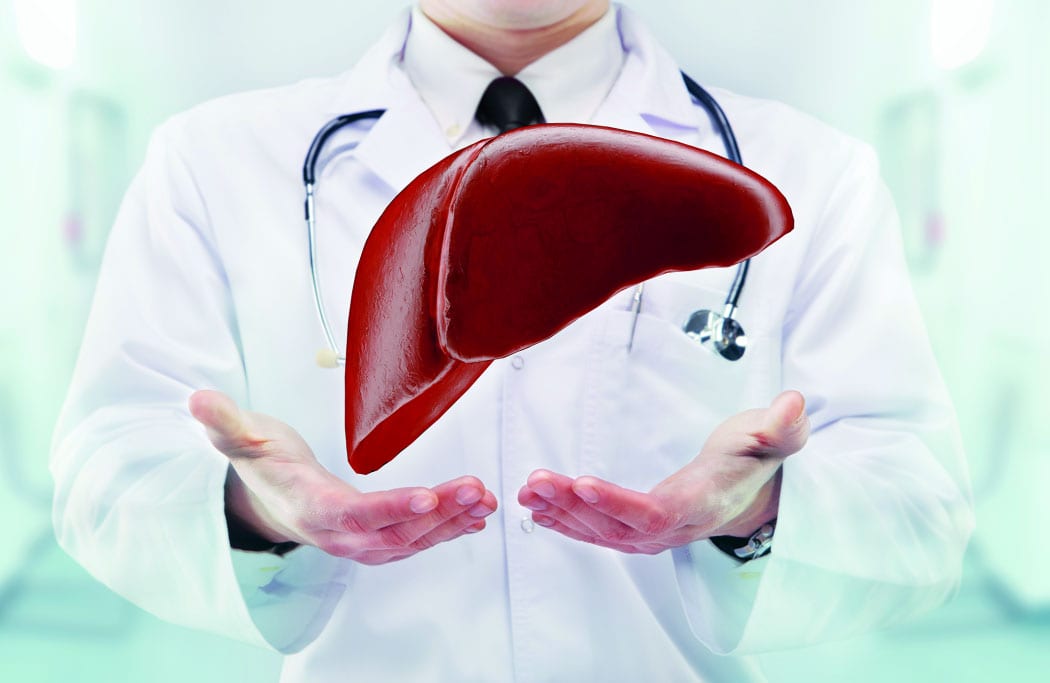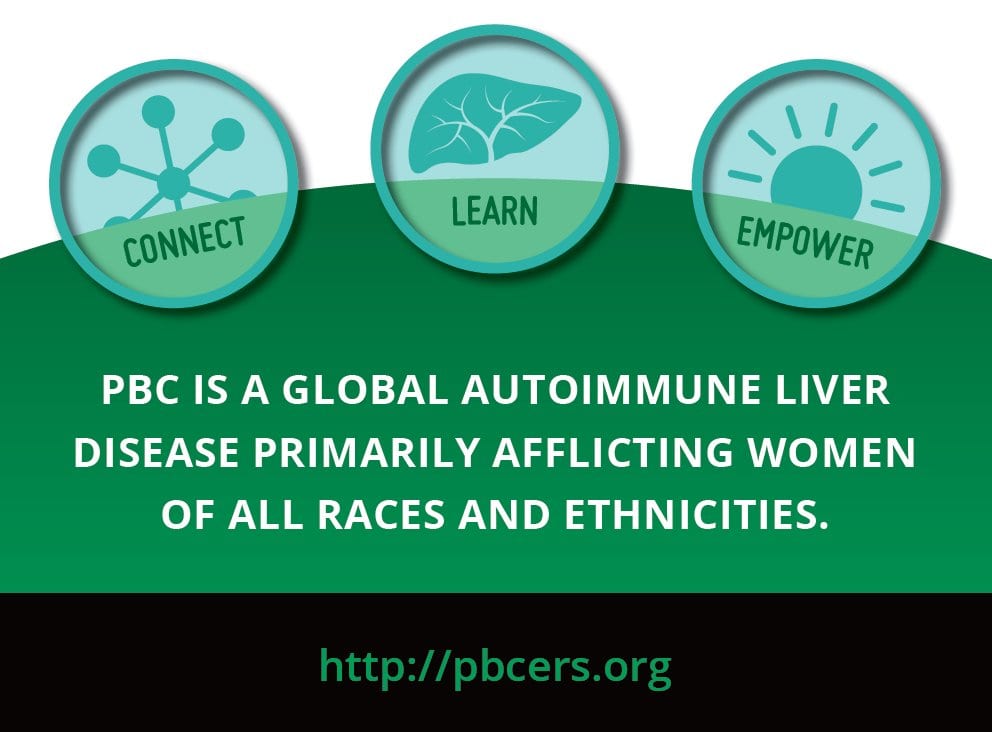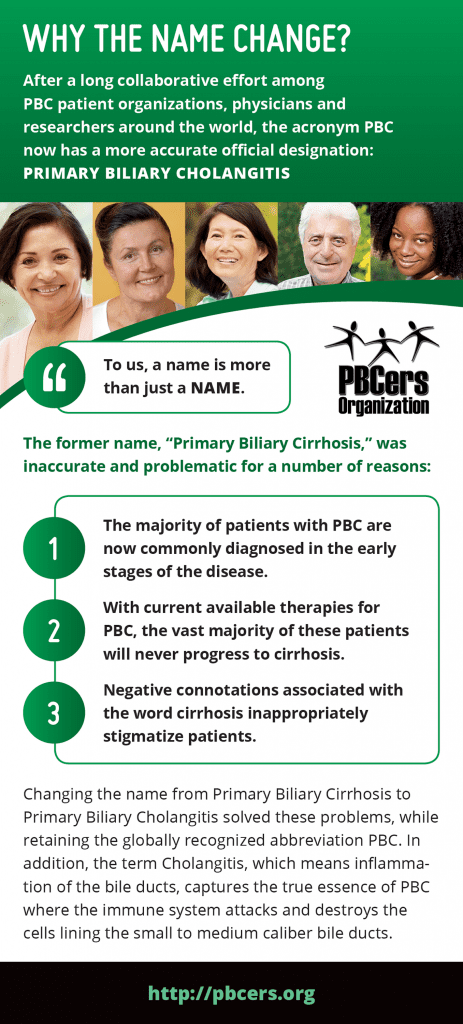
By Linie Moore
Many thanks to Doctors Melissa Palmer and Emil Miskovski for their help with this content.
Primary Biliary Cholangitis (PBC), formerly known as Primary Biliary Cirrhosis, is a chronic liver disease that slowly destroys the bile ducts within the liver (intrahepatic bile ducts). Liver inflammation over a period of years may cause scarring which leads to cirrhosis. PBC is NOT alcohol or drug related, and it is NOT contagious.
The original name “Primary Biliary Cirrhosis” is somewhat deceiving since cirrhosis only occurs in the last stage of the disease (stage 4) after many years of inflammation. With early diagnosis and proper medications, most with PBC will never reach the cirrhosis stage of PBC.
The cause of PBC is still unknown, but it is not alcohol or drug induced. Current studies suggest it may involve autoimmunity, infection, or genetic predisposition, and does seem to appear more often in certain families. Women are affected 10 times more than men, and PBC is usually diagnosed in patients between the ages of 35 to 60 years.
Those with PBC usually look extremely healthy, and many are 10 to 30 pounds overweight. The slight bronze pigmentation of the skin is often present in the advanced stage of the disease, and makes the individual look tanned. The outward appearances doesn’t tell the story of what is going on inside their bodies. Even on the transplant list stage, many with PBC look healthy. A person with PBC commonly hears comments such as “you look so healthy or you don’t look sick.”
The Diagnosis

Upon diagnosis, some doctors may suggest their patient start:
- Start a reduced sodium diet and or low fat diet.
- In severely damaged livers, proteins may be restricted.
- Drink plenty of water and other fluids such as juice.
- Calcium and Vitamin D. Calcium is the most common mineral in the body and is required for proper functioning of most organs. It is particularly needed in the normal development of the bones and teeth. Osteoporosis is a bone disease where calcium leaves the bones causing them to weaken, and is commonly associated with PBC.
- Avoid or lower intake of alcohol.
- Lower caffeine and sugar intake.
- Avoid undue stress.
- Exercise, if possible. Walking is the most common recommendation for exercise.
- Stop smoking.
The above suggestions have been found to be very helpful in liver disease, but are common sense considered part of healthy living.
The number of patients being diagnosed at the asymptomatic stage has risen dramatically over the past few years due to widespread laboratory screening. Typically, the blood lab pattern reveals an elevated alkaline phosphatase level with a normal bilirubin. Bilirubin does not increase until final disease stage. There are four disease stages of PBC.
Blood lab tests that help diagnose PBC:
- Liver function tests
- Antimitochondrial antibodies. Positive AMA is found in about 95% of PBC patients.
- Serum cholesterol and lipoproteins may be increased.
- Haptoglobin & ACE levels may be altered
Liver Biopsy & Imaging Tests:
The following tests and procedures may also be used to diagnose PBC. Liver biopsy is no longer routine for PBC diagnosis.
- Liver Biopsy – A liver biopsy helps confirms the diagnosis, but is no longer a requirement.
- MRE – Magnetic Resonance Elastography (MRE) is the most accurate for detecting liver fibrosis, particularly early-stage disease.
- MRI – Magnetic Resonance Imaging (MRI) is a test that uses a magnetic field and pulses of radio wave energy to make pictures of organs and structures inside the belly. In many cases MRI gives information about structures in the body that cannot be seen as well with an X-ray, ultrasound, or CT scan.
- Ultrasound – Ultrasound exam may be performed to visualize the bile ducts to exclude an obstruction and prior to liver biopsy.
- Fiberscan – NHA the Fibroscan device (Echosens) works by measuring shear wave velocity, and is not invasive.
PBC is considered an Autoimmune Disease
Some diagnosed with PBC, may also be diagnosed with one or more other autoimmune diseases.
See other autoimmune diseases associated with PBC.
Symptoms
Most patients remain without symptoms for many years, and some may never notice any symptoms. The initial symptoms vary among PBC patients, and the varying symptoms can sometimes make it difficult for doctors to actually diagnose PBC. The varying symptoms may be do to the individual, autoimmune nature or other diseases associated with PBC.
Disease Progression
PBC advances slowly over a period of years. Most patients lead normal lives for years without symptoms, depending on how early diagnosis is made. There is no cure for PBC, but patients are showing good results in slowing the disease progress with URSO 250, Actigall and methotrexate. With the current medications, it is becoming more common for the PBC patient to live a long life without any complications from PBC.
As the PBC progresses, some patients require vitamin A, vitamin D, vitamin E and vitamin K replacement therapy to add back fat-soluble vitamins which are lost in fatty stools. A calcium supplement may be prescribed to help prevent osteomalacia and osteoporosis.
PBC Treatments
First line treatment, Ursodiol treatments also known as URSO 250 & URSO Forte, Actigall, and generic forms of urso, as well as second line treatment Ocaliva, may help slow PBC disease progression. For some patients, they may live many years without symptoms or disease progression due to ursodiol treatments. PBC acts slightly differently in all patients, but the majority diagnosed in early PBC stage will never progress to the cirrhosis stage or need a transplant. See Ursodiol Treatment Dosage Chart.
Final Stage
When first and second line treatments no longer control the disease and PBC has progressed to an advanced stage, the patient should be evaluated for a liver transplant. The end stage of PBC is liver failure. Many signs indicate liver failure: increased bilirubin, jaundice, fluid accumulation or ascites, malnutrition, gastrointestinal bleeding, intractable itching, bone fractures and hepatic coma. Transplant is recommended before most of these symptoms occur. Recent studies suggest that 20% to 25% of those diagnosed with PBC will require a transplant. The transplant outcome for PBC patients is excellent.
As with any other chronic illness, support and understanding is very important in helping the PBC patient cope with day to day living.
Donate Now (No fees thru Paypal Giving)
To PBC Research
The PBCers Organization is a tax exempt public charity under section 501(a) of the Internal Revenue Code as an Organization described in section 501(c)(3).



